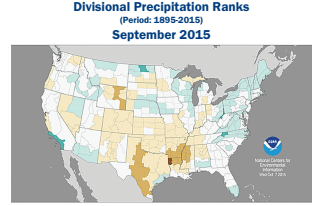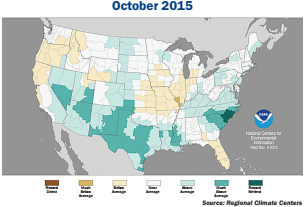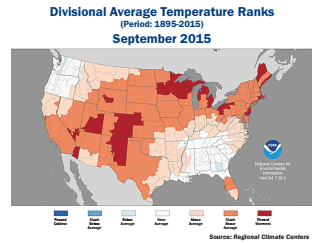C. Harvest Conditions (September – October +)
Extended warm, dry weather hastened maturation and harvest.
At the end of the growing season, dry-down of the grain is dependent upon sunshine, temperature, humidity levels, seed hybrid, and soil moisture. Corn can most effectively dry down with the least adverse impact on quality with sunny, warm days with low humidity. Another weather concern at the end of the growing season is freezing temperatures. Early freezing before the grain can sufficiently dry down may lead to lower yield, lower test weight, and/or stress cracking. Also, if harvested prematurely, higher-moisture grain may be susceptible to greater breakage than drier grain.

Typically, 80% of the U.S. corn crop is harvested by the end of October. However, in 2015, the warm late summer temperatures and dry weather hastened maturity, natural dry-down, and harvest, especially in the Southern Rail ECA. There was also no widespread early freeze that would crack grain or lead to harvest and disease issues. The decreased horneous endosperm also led to softer kernels and less stress cracking during harvest.

Fusarium-based ear mold (Gibberella ear rot) is promoted by cool temperatures and wet weather soon after pollination, which was the case in 2015, especially in the Gulf and Southern Rail ECAs. However, the mycotoxin DON that is produced by Fusarium is often associated with harvest delay or storage of high-moisture corn. The 2015 season had a quicker harvest than 2014, resulting in lesser DON levels than last year.
Additionally, aflatoxin production is favored by hot, dry, and drought conditions. While it was dry in a large central portion of the corn-growing region, the plants were not heat- stressed. Therefore, the growing conditions were not conducive to the development of the fungi that produce aflatoxins.
